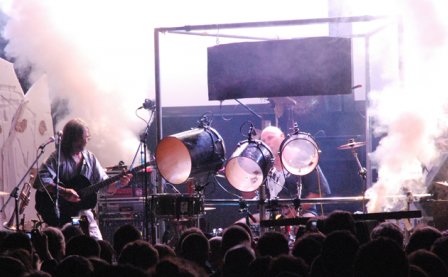Faust began confronting tired rock forms and puzzling square listeners almost 40 years ago. In the process of undermining and dismantling established sound structures, they created a space that offered a new ideal of musical playfulness that always left open an additional space for challenging its own ideal. Such an indeterminate ethos necessarily embraces a perpetual movement that resists fixity. In this movement, there is always an excitement that suffers no degradation through time, though this excitement might also be accompanied by an uncertainty of reception. Faust continues to embrace the former and remain unperturbed by the latter, displaying the same youthful, brave spirit on C’est Com…Com…Compliqué 38 years after their self-titled debut.
“Kundalini Tremolos” is a furious opener and can plausibly be considered one of Faust’s strongest side-one tracks. According to Indian yoga, Kundalini refers to an unconscious power or spirit that lies dormant in our spine and can only be awoken through particular breathing patterns and chants. For Faust, though, the deep breaths that hover over the track are not enough for total-satori and must be modified by a massive guitar tremolo that dislodges and lures the spirit up like a charmer would a snake. Diermaier’s percussion gradually travels from random clangs to total war-drum mobilization, as the kundalini gets ripped from its slumber. These spirit-summoning hypnotics crescendo and spill into the two-note organ/bass drone and tranced drum of “Accroché à Tes Lèvres.” About halfway through the track, Péron begins repeating the song title — which translates to something like “hung on your lips” — and by the time the music has built up to full-on rage, his tone is equally livid. If something is such that it cannot find a way to be successfully expressed, the act of expressing the state of frustration from inexpressibility becomes a sort of last solution — a final effort to express the inexpressible. Perhaps it’s the kundalini’s failed attempt to liberate itself from the body and go out into the world.
The tranquil disposition fostered by the smooth drum-and-bass line and ambient hum on “Ce Chemin Est Le Bon” is gradually shattered by Cambuzat’s feedback wall. It’s ambiguous whether the transition from calm to fury — a transition that returns throughout the course of the album, or better yet is the album — is referring to the frustration from the blocked road that the spirit runs into, or if the rage is in some way enabling it on its journey, pushing it along. The mission of articulation returns with “Stimmen,” as the guttural growls turn in on each other in the hopes of realizing attunement. The heaviness is momentarily broken apart by the waltzing playfulness of “Petits Son Appétissants,” in which Diermaier’s free-percussion sounds like triumphant church bells buried under a gigantic cymbal crash. Showing their steadfast refusal to acknowledge the rigid, sterilizing effect of traditionalistic categorization, on “Bonjour Gioacchino,” Faust turns Rossini’s William Tell overture into the finale of a distortion-fueled rock blazer. Having torn away those oppressive boundaries, the spirit rips into “En Veux-Tu Des Effets, En Voilà,” arguably the most furious track of the album in which the band comes together perfectly to disclose their combined powers for auditory pulverization.
The final track, the title-track, does exactly what it promises. It’s an almost 14-minute exemplification of the tensions that have been explored on the album. Through the crash of broken glass, erratically falling objects, and piercing horn blasts, we can see the outlines of something charging through a landscape that has already been partially cleared, finishing the job, and increasing its power as it moves. We might interpret this record as the journey of a creative spirit, its awakening and liberation, but also the obstacles it struggles against. The obstacles might be either internal,such that despite the desire for expression the expression always goes; or external, such that the traditional sound-power structures prevent the flight of the new creative ideal. The creative spirit, then, necessarily becomes a destructive spirit once it realizes that it must forcefully destroy what stands in its way. The complicated nature of the task is something that the creative spirit must accept. And if this complication is really just a disguised impossibility, then the impossible goal allows for the spirit to engage itself in an infinite dimension of play. It never ceases in its attempts at realization and always performs the acts of destruction and creation simultaneously.
1. Kundalini Tremolos
2. Accroché à Tes Lèvres
3. Ce Chemin Est Le Bon
4. Stimmen
5. Petits Son Appétissants
6. Bonjour Gioacchino
7. En Veux-Tu Des Effets, En Voilà
8. Lass Mich, Version Orginale
9. C’est Com…Com…Compliqué
More about: Faust




